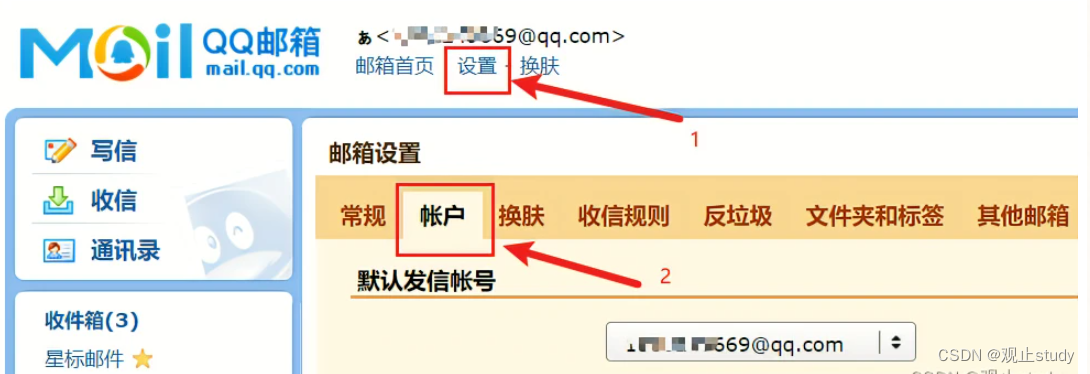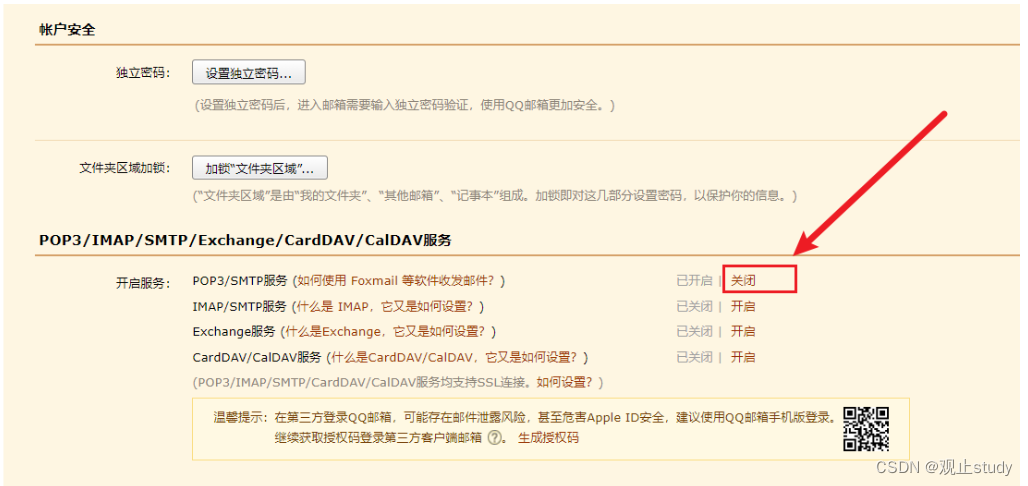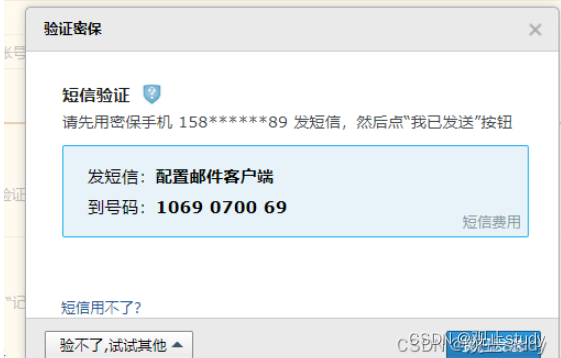最近想给自己的项目在注册时加点安全校验,本想着使用短信验证码,奈何囊中羞涩只能退而求次改用QQ邮箱验证注册~
一.需求分析
- 场景:用户输入自己的邮箱,点击获取验证码,后台会发送一封邮件到对应邮箱中。
- 分析:防止刷爆邮箱,可以限制一分钟内只能获取一次。- 前端:期限内禁用button按钮。- 后端:存入redis设置过期时间,请求先判断redis中是否有数据。
二.环境准备
(1) 邮箱环境
在QQ邮箱中开启SMTP服务,获取授权码
- 网页版:进入邮箱,点击设置中的账户

- 往下翻可以看到如下服务开关,点击开启

点击开启后会得到一串授权码,后端程序中需要用到。
- 可能会要求完成相关安全验证

(2) 后端环境
大概率是在web项目中使用到,因此我们创建一个SpringBoot工程
- 创建好项目后在pom文件中导入操作邮箱所需jar包
<!--QQ邮箱验证码所需jar包--><dependency><groupId>javax.activation</groupId><artifactId>activation</artifactId><version>1.1.1</version></dependency><dependency><groupId>javax.mail</groupId><artifactId>mail</artifactId><version>1.4.7</version></dependency><dependency><groupId>org.apache.commons</groupId><artifactId>commons-email</artifactId><version>1.4</version></dependency>
- 由于我们需要在spring项目使用redis缓存验证码因此还要导入redis的jar包
<!-- 使用redis缓存验证码时效--><dependency><groupId>org.springframework.boot</groupId><artifactId>spring-boot-starter-data-redis</artifactId></dependency>
- 在yml文件中配置redis,设置了redis密码记得加上密码配置
spring:redis:# redis数据库索引(默认为0),我们使用索引为3的数据库,避免和其他数据库冲突database:3# redis服务器地址(默认为localhost)host: localhost
# redis端口(默认为6379)port:6379
三.后端程序
(1) 效果实现
- 发送邮箱应该算个工具,因此我们可以在工具类中写入如下代码
packagecom.example.utils;importorg.apache.commons.mail.EmailException;importorg.apache.commons.mail.SimpleEmail;publicclassSendMailUtil{/**
* 发送邮件代码
*
* @param targetEmail 目标用户邮箱
* @param authCode 发送的验证码
*/publicstaticvoidsendEmailCode(String targetEmail,String authCode){try{// 创建邮箱对象SimpleEmail mail =newSimpleEmail();// 设置发送邮件的服务器
mail.setHostName("smtp.qq.com");// "你的邮箱号"+ "上文开启SMTP获得的授权码"
mail.setAuthentication("[email protected]","fbsxxxxxsijdj");// 发送邮件 "你的邮箱号"+"发送时用的昵称"
mail.setFrom("[email protected]","观止");// 使用安全链接
mail.setSSLOnConnect(true);// 接收用户的邮箱
mail.addTo(targetEmail);// 邮件的主题(标题)
mail.setSubject("注册验证码");// 邮件的内容
mail.setMsg("您的验证码为:"+ authCode+"(一分钟内有效)");// 发送
mail.send();}catch(EmailException e){
e.printStackTrace();}}}
- 编写如下接口
@RestControllerpublicclassSendMail{@PostMapping("/getCode")@ResponseBodypublicStringmail(@RequestParam("targetEmail")String targetEmail){// 随机生成六位数验证码String authCode =String.valueOf(newRandom().nextInt(899999)+100000);SendMailUtil.sendEmailCode(targetEmail,authCode);return"ok";}}
- 让我们测试一下接口
GET http://localhost:8080/[email protected]
可以看到如下效果:
如此我们初步效果就已经实现啦~
(3) 缓存改进
上述程序我们疯狂发送请求可以一直发送邮箱,这显然不是我们所期待的,接下来我们加入redis来改进一下。
@RestControllerpublicclassSendMail{@ResourceprivateRedisTemplate<String,String> redisTemplate =newRedisTemplate<>();/**
* @param targetEmail 用户邮箱
* @return
*/@GetMapping("/getCode")@ResponseBodypublicStringmail(@RequestParam("targetEmail")String targetEmail){// 发送前先看下我们是否已经缓存了验证码String yzm = redisTemplate.opsForValue().get("yzm");// 判断是否存在if(yzm ==null){// 生成六位数验证码int authNum =newRandom().nextInt(899999)+100000;String authCode =String.valueOf(authNum);// 不存在,我们发送邮箱给用户SendMailUtil.sendEmailCode(targetEmail,"你的验证码为:"+ authCode +"(五分钟内有效)");// 存入redis中,设置有效期为1分钟
redisTemplate.opsForValue().set("yzm", authCode,1,TimeUnit.MINUTES);return"发送成功";}// 存在,直接返回,不再发送邮箱~return"请勿重复发送验证码";}}
如此再次测试,可以发现疯狂点击不再产生效果,成功被拦截,如此安全了许多
至此我们开始想要的效果便已经在小demo中实现了,接下来可以引入正式自己项目啦
四.前端(补充)
用原生js简单写了一个界面,感兴趣的可以看一看
代码如下:
<!DOCTYPEhtml><htmllang="en"><head><metacharset="UTF-8"><title>Title</title></head><body><div><inputid="mail"type="text"><buttonid="getCode">获取验证码</button></div><script>/*按钮禁用60秒,并显示倒计时*/functiondisabledButton(){const getCode = document.querySelector("#getCode")
getCode.disabled =truelet second =60;const intervalObj =setInterval(function(){
getCode.innerText ="请"+ second +"秒后再重试"if(second ===0){
getCode.innerText ="获取验证码"
getCode.disabled =falseclearInterval(intervalObj);}
second--;},1000);}
document.querySelector("#getCode").addEventListener('click',function(){const mail = document.querySelector("#mail")let xhr =newXMLHttpRequest();
xhr.open("GET","http://localhost:8080/getCode?targetEmail="+ mail.value,true);
xhr.send();
xhr.onreadystatechange=function(){if(xhr.readyState ===4){alert(xhr.response);disabledButton()}}})</script></body></html>
版权归原作者 观止study 所有, 如有侵权,请联系我们删除。